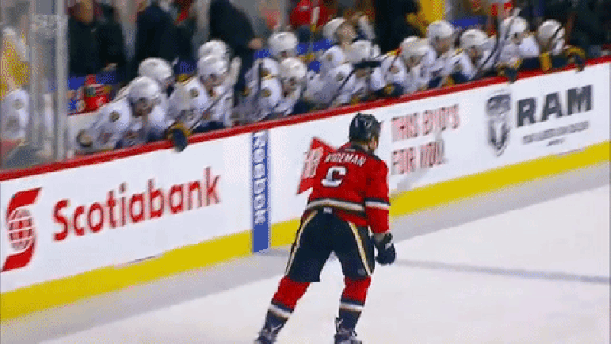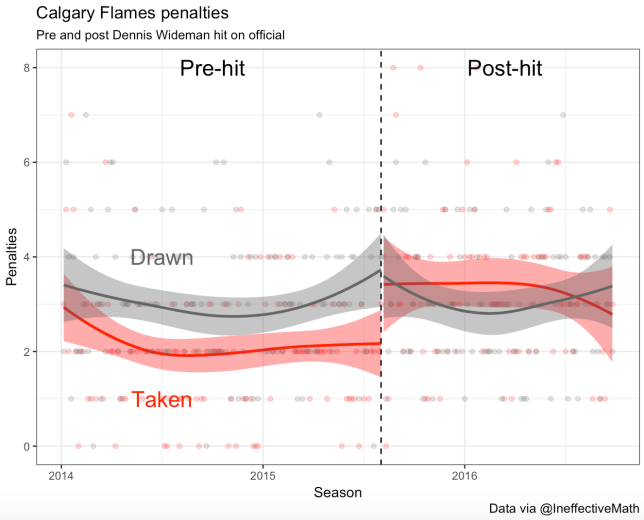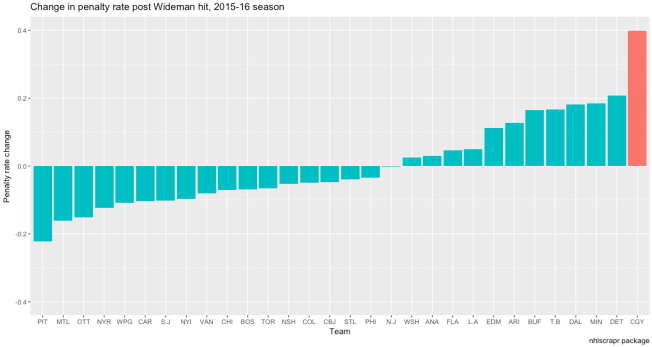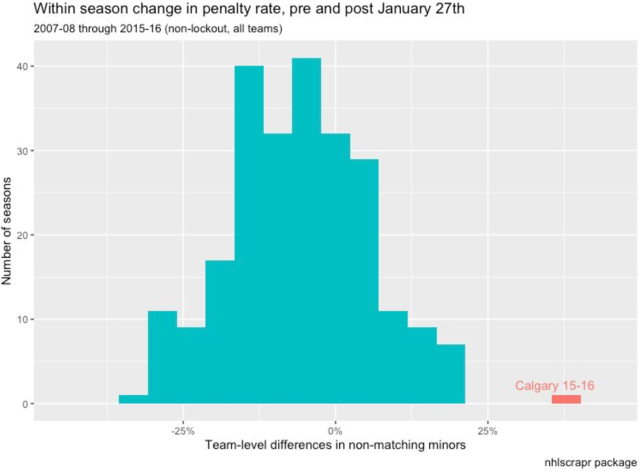Hockey die-hards like the sports’ reputation that the players police themselves. That is, teammates have one another’s backs, and acts of malice against one team will likely result in retribution against the initial aggressor.
Turns out, NHL players may not be the only ones who come to the defense of their own; there’s a decent chance that its referees do, too.
Let’s return to January of 2016, where Calgary’s Dennis Wideman leveled linesman Don Henderson with a vicious cross-check.

Despite — or perhaps given — his reputation as a high character player and the fact that post-concussive symptoms may have played a role in his mental state, Wideman was given a 20-game suspension, eventually returning to Calgary in March of last season.
But losing Wideman for 20-games wasn’t the only way in which Calgary felt the impact of the Wideman hit. From that game on, the Flames also found themselves in the penalty box significantly more often than beforehand.
Using data from Micah McCurdy (as well as some visual inspiration), I plotted the number of taken and drawn non-matching minor penalties in all Flames games since the start of the 2014-15 season. This includes the Calgary’s 129 regular season games prior to and the 92 games since the Wideman hit.

Each game is represented by a point, and the curved lines reflect local polynomial regression curves, shown separately for games before and after the hit (along with errors).
A few things stand out.
Prior to the Wideman hit, Calgary was consistently called for about one fewer penalty per game than opponents. However, while the rate of penalties drawn by Calgary has remained fairly consistent over the last 2+ seasons (shown in grey), after Wideman’s hit, there’s an immediate bump in penalties taken by Calgary (red). Comparing games pre and post-hit, the Flames jumped from 2.1 to 3.3 non-matching minors per-game. That’s … substantial, and a practically significant increase.
As additional evidence, we note that in that prior to the Wideman hit, roughly 1 in 10 Calgary games included no taken penalties. In the 92 games after the Wideman hit, the Flames only had one such game. Moreover, the jump in Calgary’s penalties corresponded with a drop in the league-wide infraction rate.
In addition to the comparison of the curves above, we can assess the significance of the Flames’ increase using the Poisson distribution. Initially linked to hockey more than a decade ago by Alan Ryder, the Poisson distribution is appropriate for penalty outcomes given the fixed amount of time in each game and the discrete counts. Sure enough, the 55% rate increase is statistically significant when comparing mean penalties pre and post-hit, and it is quite unlikely that the difference could be accounted for by chance alone. For those scoring at home, the p-value is less than 0.0001, and the 95% confidence interval for the rate increase goes from 19% to 106%.
Assuming we can rule out luck (or bad-luck) of the draw, what does this suggest?
- Officials are implicitly making more calls against Calgary to get revenge. This is more feasible given how much subjectivity is involved in several NHL violations. We already know that refs are prone to make-up calls, and that they base penalty decisions on other silly factors – so we shouldn’t be surprised that they’d take a measure of revenge, either. Wideman’s hit was egregious, and refs may be punishing his team for it.
- Another variable is responsible for the jump, but we don’t know what that variable is. As a related sports example, a few years back, an NFL analyst argued that time-varying Patriots fumble rates were a sign that New England was cheating. What was missing in the initial analysis is that there were several other reasons (e.g., more kneel downs, red zone plays, plays with the lead) driving the Pats’ low rates. Indeed, part of the reason why the Patriots didn’t fumble is because they were running plays that generally did not lead to fumbles. Could we be missing a similar confounding variable here, one that is artificially responsible for the increased penalties? Maybe. I’m open to ideas. In this respect, it’s particularly interesting the Calgary’s drawn penalties have stayed the same. The Flames don’t appear to be playing a more aggressive game since January of last year.
- Calgary wasn’t the team same after the Wideman suspension. This would stand if the jump in penalties matched the length of the Wideman suspension. In other words, perhaps Wideman’s replacements were aggressive players. However, Wideman was suspended 20 games, and the spike in penalty calls has remained much longer.
As one additional sign that (1) is responsible for part of Calgary’s jump in taken penalties, its worth revisiting the chart. If you look at the last month of play, Calgary’s taken penalty average has dipped.
At more than one penalty a game across more than a full season of play, it’s easy, albeit unsafe, to extrapolate and estimate that Calgary’s jump in penalties was worth about 20 goals against. This is an incredible total. Even if only part of Calgary’s increase in penalties was due to a revenge factor, the biggest impact of Wideman’s hit on the Flames wasn’t felt in his suspension, but in the penalty box.
Postscript: A loyal reader asked me to compare the rates of all teams, both pre and post Wideman hit. Here’s that chart, using data from the nhlscrapr package in R.

We can also look at all team-seasons across several years to get a distribution of changes in penalty rates before and after when Wideman’s hit occurred (roughly halfway through the season, on January 27). Here’s a histogram of those differences. No one’s near Calgary in 15-16.


The one issue that you should notice is that when the play moves away from the net on either side, the refs heads look towards the play and ignore what happens just behind the play. They look away as soon as the puck leaves so they miss most infractions against Calgary including high sticking, cross-checking, tripping, etc. They do not do that with other teams. They are turning a blind eye to the flames. Watch a game and it is noticeable.
I’ll add a fourth possibility – not advocating for it, just noticing it isn’t on your list. It’s possible that Wideman’s previous “high-character” reputation was decreasing the penalties called against the Flames, and the incident removed that effect.
Deryl you sir are a MORON
I guess you know as much about hockey as my neutered dead dog.
Wondering if this effect has extended to the coaches’ challenge as well. I watch every Flames game, and I can’t recall a single one being ruled in their favour this season. There have been a few goals over turned on off side calls which would require an electron microscope to see, this once even occured twice in one game. It seems as though on any video review, the Flames never get the benefit of the doubt even when the call on the ice was in their favour. Kelly Hrudey is the colour commentator for flames broadcasts, and whilst he hasnt played in quite some time, I think it is fair to say he is familiar with the rules surrounding goaltending. Kelly Hrudy’s record in predicting the outcome of challenges is laughably bad, despite the fact that he has video evidence and a wealth of experience to support his guesses. I understand that this may be difficult to prove statistically given the relatively small sample size of coaches challenges available.
Hi K S, that’s an interesting idea!
I don’t know if video review data has been along enough to infer anything at this poijnt, but it’s certainly another avenue to look for bias. In fairness to Kelly, my personal record is also laughably bad!